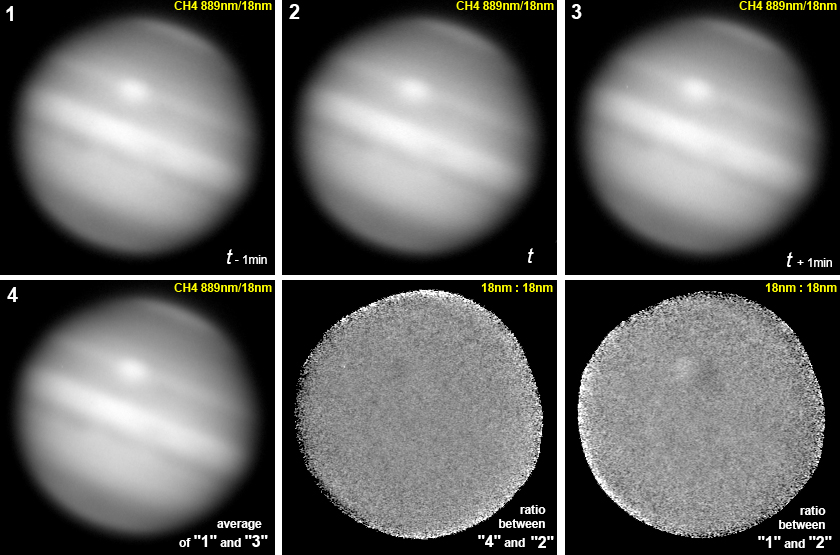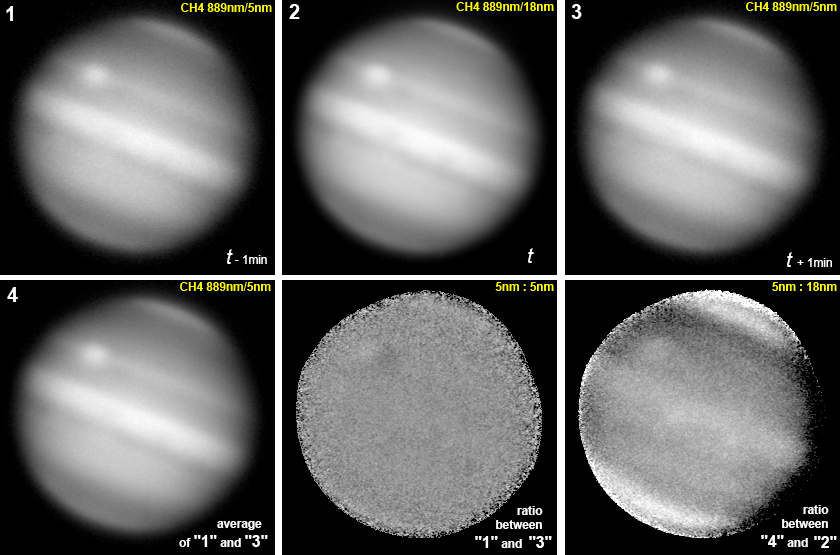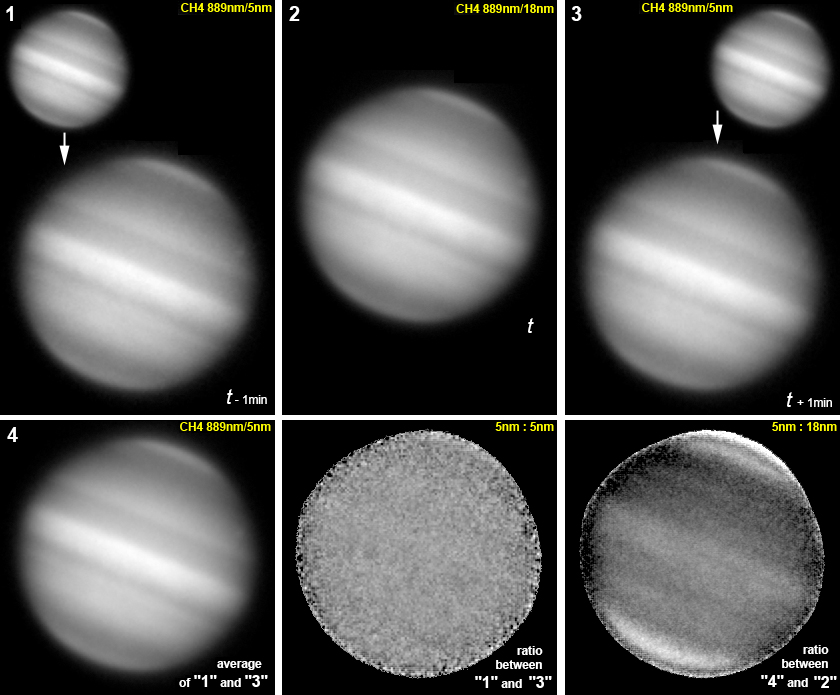
Actual
data obtained with two 889nm Methane-Band filters (5nm and 18nm FWHM)
António J. Cidadão
The example below is based on three one-minute long sequential integrations ("1", "2" and "3"), all obtained with the 889nm/18nm CH4 filter on 2009-08-29, with mid-integrations positioned at 22:52:03, 22:53:05, and 22:54:08 UT, respectively.
Image "4" is the average of images "1" and "3", compensating for planet rotation occurring between 22:52:03 and 22:54:08 UT, and thus should emulate the planet's position at 22:53:05 UT, when image "2" was obtained.
The essentially noise contribution on the ratio between images "4" and "2" confirms it, as expected from the fact that all images were obtained with the same filter.
In contrast, the ratio-image between sequential frames (e.g. "1" and "2") already starts to show the rotation-induced shift between the most contrasted planetary features, in this case the GRS.

The "blink" animation below confirms the small but effective planet rotation that occurs between images obtained at one- and two-minute intervals, and shows the virtually non-existant shift between the mid-image ("2") and the average of the first and last images ("1" and "3"). Another version of this animation can be found here.

The next example, also from 2009-08-29 and as well using three sequential images ("1" to "3", centered at 23:29:06, 23:30:10, and 23:31:14 UT) differs from the previous one in that two distinct CH4-filters were used.
The 889nm/18nm filter was ascribed to the mid-image ("2") so that the two noisier 889nm/5nm integrations, at both extremes ("1" and "3"), could be averaged to produce a better S/N ratio image ("4").
As in the previous example (see above), the ratio between images obtained with the same filter (in this case, the two 889nm/5nm frames "1" and "3") is essentially noise.
In contrast, the ratio between differently-filtered images (889nm/5nm and 889nm/18nm), without interference of planet rotation (average of frames "1" and "3" and mid-frame "2"; see above example), produces an obvious pattern.
As the chosen ratio was "5nm : 18nm", it appears that the 889nm/5nm filter elicits a stronger limb-darkening, enhances the contrast of both polar hoods and the EZ, has some minor but differential effect on the GRS, and has a strong differential influence (preferential darkening) in the jovian albedo from the temperate regions to the polar hoods.

The "blink" animation below (left- and mid-images are, respectively, raw-frames and similarly sharpened-frames obtained with both CH4-filters; right frame alternates a sharpened-image and the "5nm : 18nm" ratio-image) clearly shows the above mentioned differential effect of the two methane filters.
Moreover, it confirms that EZ bluish-festoons (NEBs projections) are, on similarly processed images, less conspicuous/contrasted with the 889nm/5nm filter than with the 889nm/18nm filter. Accordingly, NEBs projections appear as bright areas in the "5nm : 18nm" ratio-image.
On the other hand, the methane-bright Wesley's impact remnant, here seen at the "f" limb, shows higher relative-contrast with the 889nm/5nm filter. NEBs projections and Wesley's impact are marked with arrows and arrow-head, respectively, in this other version of the "blink" animation.
A putative interpretation of the different behavior of these two CH4-filters has been presented in the previous section of this page.

The next example is still from the same imaging session, now in the early hours of 2009-08-30 (frames "1" to "3" were obtained at 01:27:45, 01:28:46, and 01:29:51 UT, respectively), and differs from the previous one in that the two 889nm/5nm images were obtained with the camera binned 2x2 (to get higher S/N ratio) and then enlarged 2X to match the size of the 889nm/18nm filtered image.
Another version of the below "blink" animation can be found here, also with arrows pointing to NEBs projections and arrow-head indicating the Wesley's impact scar (now at the "p" limb).
Results are essentially similar to those mentioned earlier, but is now clearer that the bright rift at the middle of the SEB has more contrast with the 889nm/18nm filter, as have other albedo features throughout the disk (not BA, apparently).


The last example of this section was obtained in 2009-09-02, is centered at 22:35:23 UT, and to avoid repeating similar data to that shown above, only the "blink" animation is presented (a labeled version of the animation is here).
The conspicuous cyclonic region near CM (arrow-head) is darker with the 889nm/5nm filter (and also in the ratio-image).
For possible interpretation of the different behavior presented by the two CH4-filters see the end of the previous section of this page.

Go to next section of this page.